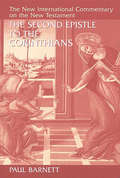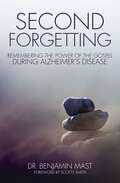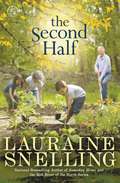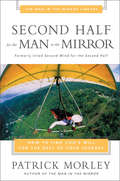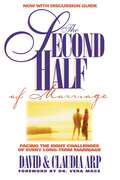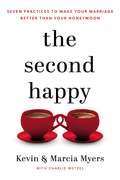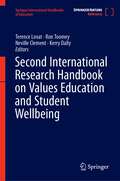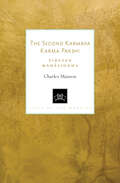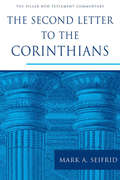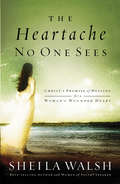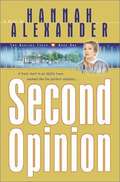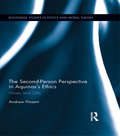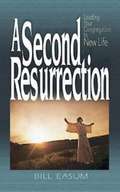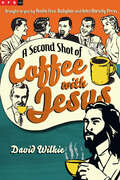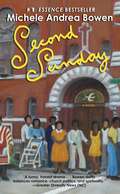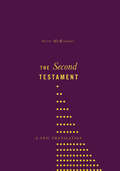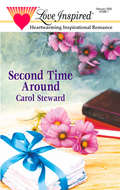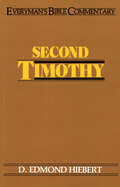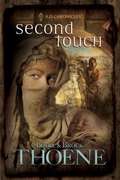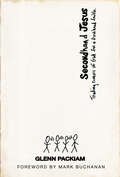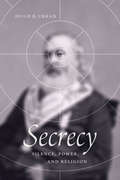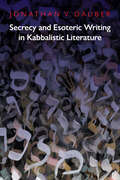- Table View
- List View
The Second Epistle to the Corinthians (The New International Commentary on the New Testament)
by Paul BarnettThis statement reflects the underlying purpose of The New International Commentary on the New Testament. Begun in the late 1940s by an international team of New Testament scholars, the NICNT series has become recognized by pastors, students, and scholars alike as a critical yet orthodox commentary marked by solid biblical scholarship within the evangelical Protestant tradition. While based on a thorough study of the Greek text, the commentary introductions and expositions contain a minimum of Greek references. The NICNT authors evaluate significant textual problems and take into account the most important exegetical literature. More technical aspects — such as grammatical, textual, and historical problems — are dealt with in footnotes, special notes, and appendixes. Under the general editorship of three outstanding New Testament scholars — first Ned Stonehouse (Westminster Theological Seminary, Philadelphia), then F. F. Bruce (University of Manchester, England), and now Gordon D. Fee (Regent College, Vancouver, British Columbia) — the NICNT series has continued to develop over the years. In order to keep the commentary “new” and conversant with contemporary scholarship, the NICNT volumes have been — and will be — revised or replaced as necessary. The newer NICNT volumes in particular take into account the role of recent rhetorical and sociological inquiry in elucidating the meaning of the text, and they also exhibit concern for the theology and application of the text. As the NICNT series is ever brought up to date, it will continue to find ongoing usefulness as an established guide to the New Testament text.
Second Forgetting: Remembering the Power of the Gospel during Alzheimer’s Disease
by Scotty Smith Dr Benjamin T. MastCharles is 78 years old and there is much he cannot remember. He cannot remember the names of his children, why he lives in a nursing home, or even whether he ate breakfast today. His forgetting causes confusion, and in his fear and uncertainty he sometimes lashes out at those who try to care for him. But when someone reads a favorite Psalm he quickly joins in, reciting each cherished word. When he hears an old hymn of faith, his hand slowly raises and he breathes out each word quietly, his face reflecting a peace that passes all understanding. Alzheimer’s disease has been described as the “defining disease” of the baby boomer generation. Millions of Americans will spend much of their retirement years either caring for a loved one with Alzheimer’s disease or experiencing its effects on their lives firsthand. When a person is diagnosed with Alzheimer’s, they face great uncertainty, knowing that they can expect to live their remaining years with increasing confusion and progressively greater reliance upon other people to care for them. As the disease advances it seems to overwhelm a person, narrowing their focus and leading them to forget critical truths about the Lord, their life with him, and his promises. Through the personal stories of those affected and the loved ones who care for them, Dr. Benjamin Mast highlights the power of the gospel for those suffering from Alzheimer’s disease. Filled with helpful, up-to-date information, Dr. Mast answers common questions about the disease and its effect on personal identity and faith as he explores the biblical importance of remembering and God’s commitment to not forget his people. In addition, he gives practical suggestions for how the church can come alongside families and those struggling, offering help and hope to victims of this debilitating disease. If you are a Christian who knows or loves someone with Alzheimer’s disease, have recently been diagnosed with early Alzheimer’s disease, or are a pastor or ministry leader seeking to better understand and minister to people with Alzheimer’s disease this book will encourage you with the good news of God’s faithfulness and the future hope he calls us to.
The Second Formation of Islamic Law
by Guy BurakThe Second Formation of Islamic Law is the first book to deal with the rise of an official school of law in the post-Mongol period. The author explores how the Ottoman dynasty shaped the structure and doctrine of a particular branch within the Hanafi school of law. In addition, the book examines the opposition of various jurists, mostly from the empire's Arab provinces, to this development. By looking at the emergence of the concept of an official school of law, the book seeks to call into question the grand narratives of Islamic legal history that tend to see the nineteenth century as the major rupture. Instead, an argument is formed that some of the supposedly nineteenth-century developments, such as the codification of Islamic law, are rooted in much earlier centuries. In so doing, the book offers a new periodization of Islamic legal history in the eastern Islamic lands.
The Second Half: A Novel
by Lauraine SnellingBestselling author Lauraine Snelling shares a heartfelt story of a couple who put their plans for a peaceful retirement on hold to assume guardianship of their young grandchildren. Mona and Ken Sorenson are approaching the best years of their lives. Mona's greatest concern is that Ken will learn of the surprise party she's planning for his retirement from his job as Dean of Students at Stone University. They've already been making plans to travel, spend limitless hours in the garden, and Ken is looking forward to working on his woodworking and fishing with his grandchildren. It's what they deserve after years of careful planning. But things begin to unravel when Ken learns that office politics are about to destroy his department. Can he really just leave, abandoning the work he spent a lifetime achieving? Mona is eager to build her event planning business with Ken's help, but rather than supporting her, he expresses concern that the stress of the work will send her back into the depression she struggles with. Then, just days before Ken's last official day of work, their son, a Special Forces officer in the Army, learns he's being immediately deployed on a six-month mission in Pakistan. Since his wife left him, the only people he trusts to care for his two young children are his parents. In an instant, everything Ken and Mona spent their lives planning changes, and they will need to find strength, both physical and mental, to become parents once more. This is not the second half they wanted, and when their son fails to contact them as planned, they struggle to trust that it is God's plan, not theirs, that matters most.
Second Half for the Man in the Mirror
by Patrick Morley"Like a good coach at ‘halftime,’ Morley helps men evaluate their past mistakes and provides the kind of practical insights, encouragement, and inspiration that will help them ‘run to win’ the rest of the way--and reach their full potential in Christ."--Bill McCartney, founder & CEO, Promise Keepers "Morley’s analogy of the ‘midlife lake’ is worth the price of the book. He asks the right questions and rightly predicts that your ‘second half’ can be the most significant part of your life."--Bob Buford, author of Halftime Refocus Your Life The first part of your life was like a river running swiftly within its banks. You were working hard to make your mark. You were intense. Focused. Then your river broadened into a lake. Now you find it hard to focus. Often, instead of feeling drive and purpose, you feel distracted--even insignificant. Patrick Morley shows how this season of perplexity can become a man’s golden opportunity to “reinvent” himself for life’s second half. If this sounds like you--or someone you know and love--this book is exactly what you’re looking for. Morley gives biblical insights, lived out in the crucible of his own life experience. This book will help you redefine your vision, your goals, and the heart that drives them. Second Wind for the Man in the Mirror will help you find a fresh sense of authenticity. Once again, you’ll feel your life regaining speed as the waters are gathered by the converging riverbanks just ahead.
The Second Half of Marriage: Facing the Eight Challenges of the Empty-Nest Years (Second Half of Marriage)
by David ArpYour children are gone or leaving soon. It's time to focus once again on your own future and especially on your marriage. What's in store for the second half? David and Claudia Arp provide answers and practical help in this groundbreaking book. Drawing on their national survey of hundreds of "second-half" couples, the Arps reveal eight marital challenges every long-term marriage faces, and they offer strategies and exercises for meeting each of them. The Second Half of Marriage will challenge you to create a vision for the rest of your life together -- and inspire you to make that vision a reality.
Second Hand Heart
by Joyce LivingstonA bout of rheumatic fever left Rosalinda Sammy Samuels in need of a new heart. Three years ago she received it--and her vagabond sister's three children to raise. On a rare day to herself, Sammy meets Ted and dares to wonder if he could be the One... until she learns of his distaste of children... and transplants. Ted Benay lost his sister in a car accident, but his parents gave away her heart. The loss has haunted Ted ever since. Because of her death, Ted questions God. Now he's opened his apartment to his brother's unruly, disrespectful family, and Ted's pretty sure he never wants such a thing for himself. When he meets Sammy, though, his deepest convictions and opinions are challenged. Can it be for the better? Sammy's new heart gives her a second chance at life. But has it also stolen her only chance of love?
The Second Happy: Seven Practices to Make Your Marriage Better Than Your Honeymoon
by Kevin and MyersWhat is the secret to a healthy, happy, fulfilling marriage?Nearly every marriage starts out happy, and if we're honest, nearly every marriage at some point becomes unhappy. Is there a solution? Can an unhappy marriage really get back to being happy? Can it be truly and authentically happy--even better than it was at first? Kevin and Marcia Myers, married for thirty-seven years through nearly every challenge a couple can face, emphatically say yes. Revealing seven practices that offer help and hope for a happy and enduring marriage, The Second Happy is a captivating, practical resource that provides the tools necessary to tune-up, overhaul, or even rebuild your marriage. Practices to sustain and strengthen marriage include the following:breaking the quit cycle;picking a fair fight so both people win;keeping disagreements from escalating; andremoving pretense from your relationship.Rooted in Scripture and contemporary insights from the Myers' marriage, as well as real stories from other couples, this revelatory book shows how any marriage can regain depth, meaning and, yes, happiness.
Second International Research Handbook on Values Education and Student Wellbeing (Springer International Handbooks of Education)
by Terence Lovat Ron Toomey Neville Clement Kerry DallyThis collection applies the principles underlying values education to addressing the many social and learning challenges that impinge on education today . Insights in the fields of social and emotional learning, student wellbeing, and, increasingly, educational neuroscience have demonstrated that values education represents an efficacious pedagogy with holistic effects on students across a range of measures, including social, emotional, and intellectual outcomes. With schools in the 21st century confronting issues such as gender identity, stemming radicalism, mental health, equity for disadvantaged groups, bullying, respect, and the meaning of consent, values education offers a way of teaching and learning that integrates and enhances student’s affective and cognitive functioning. The earlier edition of this book has become a standard reference for scholars and practitioners in the fields of values education, moral education, and character education. Its citation rates, reads and downloads have been consistently and enduringly high, as have those of its companion text, Values Pedagogy and Student Achievement. A decade on, the main purpose of the revised edition is to update and incorporate new research and practice relevant to values education. Recent insights in the fields of neuroscience and social and emotional learning and their implications for education and student wellbeing are more overt than they were when the first edition was being compiled. Additionally, advanced thinking in the field of epistemology, how humans come to know and therefore learn, has also sharpened, especially through the later writings of prominent scholars like Jurgen Habermas. The revised edition has preserved the essential spirit and thrust of the original edition while making space for some of these new insights about the potential of values education to establish optimal and harmonious learning and social environments for both students and teachers.
The Second Karmapa Karma Pakshi: Tibetan Mahasiddha
by Charles MansonThe life and writings of a Tibetan meditation master who became the Buddhist priest to two Mongol emperors and is recognized as one of the earliest reincarnated lamas in Tibet.Karma Pakshi is considered influential in the development of the reincarnate lama tradition, a system that led to the lineage of the Dalai Lamas. Born in East Tibet in the thirteenth century, Karma Pakshi himself was the first master to be named Karmapa, a lineage that continues to modern times and has millions of admirers worldwide. During his lifetime, Karma Pakshi was widely acknowledged as a mahāsiddha—a great spiritual adept—and was therefore invited to the Mongol court at the apogee of its influence in Asia. He gave spiritual advice and meditation instructions to the emperor Mӧngke Khan, whom he advised to engage in social policies, to release prisoners, and to adopt a vegetarian diet. After Mӧngke&’s death, Karma Pakshi was imprisoned by the successive emperor Kubilai Khan, and much of Karma Pakshi&’s writing was done while he was captive in northeast China. He was eventually released and returned to Tibet, where he commissioned one of the medieval world&’s largest metal statues: a seated Buddha sixty feet high. Centuries later, two Buddhist meditation masters, the First Mingyur Rinpoche and Chӧgyam Trungpa Rinpoche, were inspired by Karma Pakshi to write meditation practices that are profoundly important to contemporary Tibetan Buddhist practitioners: respectively, the Karma Pakshi Guru Yoga and the Sādhana of Mahāmudrā. This first-ever comprehensive biography of Karma Pakshi in English reveals new information about a pivotal historical figure in the development of Tibetan Buddhism and his interactions with two Mongol emperors. Also included are translations of several newly available songs attributed to Karma Pakshi and translations of ten excerpts of his writings on reincarnation, meditation, dreams, visionary experiences, tantra, and consecration. Details on the music of Karma Pakshi's singing of the maṇi mantra are also given.
The Second Letter to the Corinthians (The Pillar New Testament Commentary (PNTC))
by Mark A. SeifridNewest volume in the acclaimed Pillar New Testament Commentary series The question that Paul set before the ancient church in Corinth -- Do you not recognize that Jesus Christ is in and among you? (2 Cor 13:5) -- remains a critical question for the church today. This commentary by Mark Seifrid seeks to hear Paul’s message afresh and communicate it to our time. Seifrid offers a unified reading of 2 Corinthians, which has often been regarded as a composite of excerpts and fragments. He argues that Paul’s message is directed at the “practical atheism” of the Corinthian church -- the hidden heresy that assumes God’s saving work in the world may be measured by outward standards of success and achievement. Like all of the Pillar volumes, Seifrid’s commentary on 2 Corinthians offers careful grammatical analysis and exegesis with clear pastoral application.
The Second Most Important Book You Will Ever Read: A Personal Challenge to Read the Bible
by Dan PatrickSo what's your excuse for failing to read the MOST important book ever written, the Bible? Don't think you can understand the Bible? No time for Bible reading? No relevancy of the Bible to your life? Questions about the Bible's authenticity? Although most Americans own a Bible, polls show that few people have read the Bible or even parts of it. Perhaps what most Americans don't know is that the Bible has life-changing information about how to get right with God know why you are alive today receive God's guidance...daily get through tough times have a successful marriage and family life know what you really believe with confidence manage your money and resources communicate with God build good relationships prepare for the future Dan Patrick's book is for those with little or no faith in God...for those who attend church but haven't read the Bible...and for serious Bible students. Read it, and then give a copy to a friend.
Second Opinion (The Healing Touch, Book #1)
by Hannah AlexanderLauren McCaffrey, an experienced ER nurse, arrives in Dogwood Springs, Missouri, hoping for a fresh start in her career--and a convenient escape from her family's humiliating pressure for her to find a husband. Dr. Grant Sheldon transfers to the local hospital in search of a nurturing environment for his twins, who are still grieving the death of their mother. His idyllic setting is not free of all the problems he thought he had left behind. When the community's tranquility is threatened by a drug ring and a mysterious epidemic, Grant and Lauren find themselves racing the clock in a desperate search for answers. Second Opinion combines emergency medicine and small-town America in a story of love's discovery and a faith that lasts.
The Second-Person Perspective in Aquinas’s Ethics: Virtues and Gifts (Routledge Studies in Ethics and Moral Theory #17)
by Andrew PinsentThomas Aquinas devoted a substantial proportion of his greatest works to the virtues. Yet, despite the availability of these texts (and centuries of commentary), Aquinas’s virtue ethics remains mysterious, leaving readers with many unanswered questions. In this book, Pinsent argues that the key to understanding Aquinas’s approach is to be found in an association between: a) attributes he appends to the virtues, and b) interpersonal capacities investigated by the science of social cognition, especially in the context of autistic spectrum disorder. The book uses this research to argue that Aquinas’s approach to the virtues is radically non-Aristotelian and founded on the concept of second-person relatedness.To demonstrate the explanatory power of this principle, Pinsent shows how the second-person perspective gives interpretation to Aquinas’s descriptions of the virtues and offers a key to long-standing problems, such as the reconciliation of magnanimity and humility. The principle of second-person relatedness also interprets acts that Aquinas describes as the fruition of the virtues. Pinsent concludes by considering how this approach may shape future developments in virtue ethics.
A Second Resurrection: Leading Your Congregation to New Life
by William M. EasumFor many congregational and denominational leaders, the goal for churches experiencing declining worship attendance is to turn those congregations around. The "turnaround church" is one that has stagnated or is in decline. The old trends are reversed, new members are added, and everyone rejoices in this story of a congregation restored to health and vitality. But what if the metaphors of decline, stagnation, and loss of health just aren't getting to the problem? What if the situation is much worse than what those ways of describing it imply? What if the congregation is spiritually dead? The only solution is resurrection. Churches that have lost their sense of mission, that exist only to provide fellowship for the "members of the club," that expect their leaders to focus solely on ministering to the members' personal spiritual needs; these churches have died to the purpose of the New Testament church, to make disciples of Jesus Christ. They cannot be turned around; they must come to life again. The key to that resurrection is leaders who are not afraid to diagnose the problem for what it really is, and who realize that resurrection is what being a Christian is about. The goal of this book is to guide the leaders of these churches through the painful, yet ultimately life-giving work of leading a church to new life in the Spirit. If you want to find new life for your church, read on . . .
A Second Shot of Coffee with Jesus
by David WilkieForeword Reviews' 18th Annual INDIEFAB Honorable Mention for Graphic Novels and Comics
Second Sunday
by Michele Andrea BowenThis story is set in St. Louis in the 1970s. The 100th year anniversary celebration of Gethsemane Missionary Baptist Church is approaching and the pastor has died. How will the church pull itself back together and find a new pastor in time to prepare for the church centennial, let alone survive one more day? It seems as though everyone in the church has an idea about who the new pastor needs to be and what direction he should be going. In the tradition of Gloria Naylor's Women of Brewster Place, Bowen weaves the hilarious stories of several church members as they plan, plot, and connive to have their choice installed as the next pastor before the anniversary celebrationSecond Sunday refers to one of the main worship Sundays in small traditional Baptist churches. In the book, it is the day of the scheduled centennial celebration.
The Second Testament: A New Translation
by Scot McKnightExperience the New Testament afresh in Scot McKnight's bold translation. Typical translations of the New Testament make the biblical text as accessible as possible by using the language of our own day. At times this masks the distance between the New Testament text and modern readers. Scripture continues to speak to us but it speaks as an ancient text to the modern world. New Testament scholar Scot McKnight offers a translation of the New Testament with a daring approach to the ancient text. Clever in its expression and at times stunning in its boldness, The Second Testament will challenge readers to experience God's Word anew. God blesses the beggars in spirit because theirs is Heavens’ Empire. God blesses the grievers because they will be consoled. God blesses the meek because they will inherit the land. God blesses the ones hungering and thirsting for the rightness because they will be satisfied. (Matthew 5:3-6) Features include: Complete text of the New Testament Brief introductions to each book Maps of key locations and events Glossary of key terms in the translation Full-cloth hardcover with foil stamping
Second Time Around
by Carol StewardANOTHER CHANCEKevin MacIntyre's heart stopped when he saw his ex-fiancée, Dr. Emily Berthoff, at his best friend's wedding. She was more beautiful than ever and nothing had changed. His bitterness over her departure was still strong-and so was his love.Emily Berthoff had taken a job back home to be closer to her family. And though she knew running into Kevin was inevitable, she was startled to find her feelings for him were more powerful than before. The love that had haunted her all these years was still there.But could they forgive one another and start again?
Second Timothy- Everyman's Bible Commentary (Everyman's Bible Commentaries)
by D Edmond HiebertA reliable guide to Paul's last letter is provided by D. Edmond Hiebert in this concise interpretation of 2 Timothy. The verse-by-verse exposition offers a systematic explanation of the entire book. A comprehensive outline accurately follows the progression of Paul's thought, giving a quick overall view of the contents.Second Timothy is the most personal of the Pastoral Epistles. It was written shortly before Paul's martyrdom and contains intimate words of lasting significance. The apostle's special concern for both Timothy and the people he served is laid bare in this touching letter of instruction and encouragement.Second Timothy is characterized by clear expression and a penetrating analysis of this epistle written to a son in the faith. The outline is designed as a chart and guide to the meaning of the epistle and is interspersed in the interpretative text. Technical matters have been kept to a minimum but discussion of the Greek is included where such commentary is needed.
Second Timothy- Everyman's Bible Commentary (Everyman's Bible Commentaries)
by D Edmond HiebertA reliable guide to Paul's last letter is provided by D. Edmond Hiebert in this concise interpretation of 2 Timothy. The verse-by-verse exposition offers a systematic explanation of the entire book. A comprehensive outline accurately follows the progression of Paul's thought, giving a quick overall view of the contents.Second Timothy is the most personal of the Pastoral Epistles. It was written shortly before Paul's martyrdom and contains intimate words of lasting significance. The apostle's special concern for both Timothy and the people he served is laid bare in this touching letter of instruction and encouragement.Second Timothy is characterized by clear expression and a penetrating analysis of this epistle written to a son in the faith. The outline is designed as a chart and guide to the meaning of the epistle and is interspersed in the interpretative text. Technical matters have been kept to a minimum but discussion of the Greek is included where such commentary is needed.
Second Touch (A. D. Chronicles® #Book 2)
by Bodie Brock Thoene2005 Gold Medallion Award finalist! Be transported once again to the dark and tumultuous times of first-century Jerusalem. Return to the story of Peniel, the no-longer-blind beggar who still longs for the connection of home and family. Meet new characters like Lily, Cantor, and Rabbi Ahava, who hold on to hope in spite of their devastating affliction of leprosy. This book's rich, vibrant imagery will draw readers to discover that we all need Yeshua's touch, not only on our bodies but on our souls.
Secondhand Jesus
by Glenn PackiamGod has offered us firsthand knowledge of His love, His grace, and His power. Yet so often, we too easily settle for someone else's descriptions, the Cliff notes from another's spiritual journey. We are content for "God-experts" to do the heavy lifting and then give us the bottom line. And like any secondhand information, after enough times through the grapevine, the truth about God deteriorates and crumbs of rumor are all that remain.But when life derails, and things don't go as we had planned, our thin view of God is challenged. In those critical moments, we can choose to walk away from God, or to let our questions lead us home. When we choose to wrestle with God, to engage Him for ourselves, we-like Jacob and Job and David-will see rumors die and revelation come alive.It's time to hear the magnificent, Divine Invitation. It's time to take God up on His offer and embrace the mystery and majesty of knowing Him for ourselves.
Secrecy: Silence, Power, and Religion
by Hugh B. UrbanThe powers of political secrecy and social spectacle have been taken to surreal extremes recently. Witness the twin terrors of a president who refuses to disclose dealings with foreign powers while the private data of ordinary citizens is stolen and marketed in order to manipulate consumer preferences and voting outcomes. We have become accustomed to thinking about secrecy in political terms and personal privacy terms. In this bracing, new work, Hugh Urban wants us to focus these same powers of observation on the role of secrecy in religion. With Secrecy, Urban investigates several revealing instances of the power of secrecy in religion, including nineteenth-century Scottish Rite Freemasonry, the sexual magic of a Russian-born Parisian mystic; the white supremacist BrüderSchweigen or “Silent Brotherhood” movement of the 1980s, the Five Percenters, and the Church of Scientology. An electrifying read, Secrecy is the culmination of decades of Urban’s reflections on a vexed, ever-present subject.
Secrecy and Esoteric Writing in Kabbalistic Literature (Jewish Culture and Contexts)
by Jonathan DauberSecrecy and Esoteric Writing in Kabbalistic Literature examines the strategies of esoteric writing that Kabbalists have used to conceal secrets in their writings, such that casual readers will only understand the surface meaning of their texts while those with greater insight will grasp the internal meaning. In addition to a broad description of esoteric writing throughout the long literary history of Kabbalah, this work analyzes kabbalistic secrecy in light of contemporary theories of secrecy. It also presents case studies of esoteric writing in the work of four of the first kabbalistic authors—Abraham ben David, Isaac the Blind, Ezra ben Solomon, and Asher ben David—and thereby helps recast our understanding of the earliest stages of kabbalistic literary history.The book will interest scholars in Jewish mysticism and Jewish philosophy, as well as those working in medieval Jewish history. Throughout, Jonathan V. Dauber has endeavored to write an accessible work that does not require extensive prior knowledge of kabbalistic thought. Accordingly, it finds points of contact between scholars of various religious traditions.
